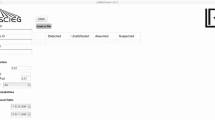Abstract
This article discusses two factors that may profoundly affect the value of DNA evidence for proving that two samples have a common source: uncertainty about the interpretation of test results and the possibility of laboratory error. Three case studies are presented to illustrate the importance of the analyst's subjective judgments in interpreting some RFLP-based forensic DNA tests. In each case, the likelihood ratio describing the value of DNA evidence is shown to be dramatically reduced by uncertainty about the scoring of bands and the possibility of laboratory error. The article concludes that statistical estimates of the frequency of matching genotypes can be a misleading index of the value of DNA evidence, and that more adequate indices are needed. It also argues that forensic laboratoires should comply with the National Research Council's recommendation that forensic test results be scored in a blind or objective manner.
Similar content being viewed by others
References
Devlin, B., N. Risch & K. Roeder, 1994. Comments on the statistical aspects of the NRC's report on DNA typing. J. Forensic Sci. 39: 28–40.
Graves, M.H. & M. Kuo, 1989. DNA: A blind trial study of three commercial testing laboratories. Presented at the meeting of the American Academy of Forensic Sciences, Las Vegas.
Hagerman, P.J., 1990. DNA typing in the forensic arena. Am. J. Hum. Genet. 47:876–877.
Hart, S.D., C. Webster & R. Menzies, 1993. A note on portraying the accuracy of violence predictions. Law & Hum. Behav. 17: 695–700.
Kaye, D.H., 1994. DNA evidence: Probability, population genetics and the courts. Harvard J. Law & Technology 7:101–172.
Koehler, J.J., 1993a. DNA matches and statistics: Important questions, surprising answers. Judicature 76:222–229.
Koehler, J.J., 1993b. Error and exaggeration in the presentation of DNA evidence at trial. Jurimetrics 34:21–35.
Lander, E., 1989. DNA fingerprinting on trial. Nature 339:501–505.
Lempert, R., 1991. Some caveats concerning DNA as criminal identification evidence: With thanks to the reverend Bayes. Cardozo L. Rev. 13:303–341.
Moenssens, A.A., 1990. DNA evidence and its critics—How valid are the challenges? Jurimetrics 31:87–108.
National Research Council, 1992. DNA Technology in Forensic Science. National Academy Press, Washington, D.C.
Nisbett, R.E. & L. Ross, 1980. Human inference: Strategies and shortcomings of social judgment. Prentice-Hall, Englewood Cliffs, New Jersey.
People v. Castro, 545 N.Y.S.2d 985 (N.Y.Sup.Ct. 1989).
People v. Keene, 591 N.Y.S.2d 733 (N.Y.Sup.Ct. 1992).
Shields, W.M., 1992. Forensic DNA typing as evidence in criminal proceedings: Some problems and potential solutions, pp. 1–50 in Proceedings from the Third International Symposium on Human Identification. Promega Corp., Madison, Wisconsin.
State v. Futch, 860 p.2d 264 (Ore. 1993).
State v. Jobe, 486 N.W.2d 407 (Minn. 1992).
Technical Working Group on DNA Analysis Methods (TWIGDAM), 1990. Statement of the Working Group on Statistical Standards for DNA Analysis. Crime Lab. Dig. 17(3):53–58.
Thompson, W.C. & S. Ford, 1989. DNA typing: Acceptance and weight of the new genetic identification tests. Virginia L. Rev. 75:45–108.
Thompson, W.C. & S. Ford, 1991. The meaning of a match: Sources of ambiguity in the interpretation of DNA prints, pp. 93–152 in Forensic DNA Technology, edited by M. Farley & J. Harrington, Lewis Publishers, Chelsea, Michigan.
Thompson, W.C., 1993. Evaluating the admissibility of new genetic identification tests: Lessons from the “DNA War”. J. Crim. Law & Criminology 84:701–781.
Weir, B.S., 1992. Population genetics in the forensic DNA debate. Proc. Natl. Acad. Sci. 89:11654–11659.
Author information
Authors and Affiliations
Additional information
Editor's comments
The author treats the timely and important issue of laboratory error. Readers will need to read the paper by Lempert in this volume for an alternative interpretation of the 1989 proficiency testing of Cellmark diagnostics.
Rights and permissions
About this article
Cite this article
Thompson, W.C. Subjective interpretation, laboratory error and the value of forensic DNA evidence: Three case studies. Genetica 96, 153–168 (1995). https://doi.org/10.1007/BF01441161
Received:
Accepted:
Issue Date:
DOI: https://doi.org/10.1007/BF01441161




